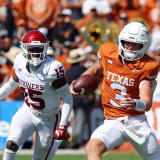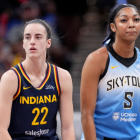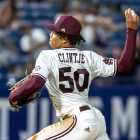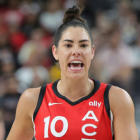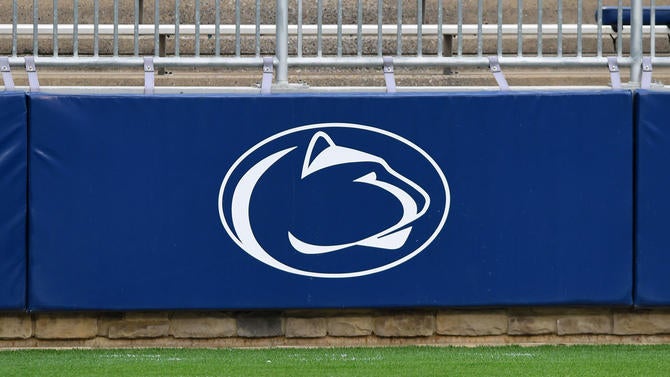
Former college football players at Penn State, Auburn, Georgia, Oregon, Utah and Vanderbilt are suing the NCAA, their former conference and -- in some instances -- their former school over how their concussions were treated.
Six class-action lawsuits filed Tuesday represent the start of the next wave of concussion litigation in college sports, even as the NCAA finalizes a $75 million settlement from a different lawsuit related to concussions. Chicago attorney Jay Edelson, who is leading this latest effort to sue the NCAA, said 40 to 50 class-action lawsuits will eventually get filed on behalf of tens of thousands of ex-football players.
"The goal of the suits is to get people who are injured financial compensation -- something that hasn't happened as of yet," Edelson said.
A federal judge in Illinois gave preliminary approval in January to the NCAA's settlement from a 2011 lawsuit brought by former Eastern Illinois football player Adrian Arrington over how the association handled concussions. The judge had one significant caveat: Athletes could still sue their university, conference and the NCAA as a class under certain terms, meaning the NCAA didn't receive the blanket immunity it sought.
Edelson fought the Arrington settlement for two years because he said it changed from a lawsuit about personal injuries into one strictly about medical monitoring. Under the proposed Arrington settlement, the NCAA will create a $70 million fund to test thousands of current and former athletes for brain trauma and put aside $5 million for concussion research. The settlement doesn't pay medical costs for ex-players suffering from brain injuries. Arrington, one of the named plaintiffs, opposed the settlement and other plaintiffs signed off on it.
Edelson's current batch of lawsuits tries to include groups of ex-players at individual schools going back 50 to 60 years until 2010. The end date is 2010 because that's when the NCAA passed legislation requiring schools to have a concussion management plan and return-to-play protocols.
The NCAA and a player's conference are defendants in all of Tuesday's cases. Some of the lawsuits don't name the university as a defendant because state schools often have sovereign immunity from liability, Edelson said.
"We thought the most efficient case was to file one large suit against the NCAA, and they blocked that and said in order to proceed, we have to file on behalf of classes only comprised of one school and one sport," Edelson said. "I think they were betting we didn't have the resources to do that. We do. We sue Facebook and Google. The NCAA isn't any more intimidating than those companies."
Edelson said about 10 law firms are working on the concussions cases. Most of the lawsuits will be against universities with wealthy football programs and likely will get filed in batches about every other week, he said.
The first lawsuits were filed separately in various districts around the country, often avoiding the jurisdiction of the ex-player's university. In some cases, the jurisdiction was where the named plaintiff currently lives or where the NCAA or conference is located. The initial batch of plaintiffs are:
* Penn State -- Robert Samuels (defensive back, 1988-89), James Boyd (safety, 1997-2001) and Eric Ravotti (linebacker, 1990-94) are suing Penn State, the NCAA and Big Ten in the Northern District of Illinois. Boyd was a Jim Thorpe Award semifinalist in 2000. Their suit generically says that all three men currently suffer with their cognitive functioning, such as loss of memory and mood swings.
Update I: Boyd is no longer a named plaintiff in the Penn State lawsuit. In a statement sent Tuesday night via e-mail, Boyd said he was not made aware that either Penn State or the Big Ten would be a defendant and neither was named in the paperwork that he signed. "I am keenly aware of the evidence of long-term damage from concussions and generally support ongoing research and investigation of the subject," Boyd wrote. "I do not wish to have my Penn State football experience characterized as anything other than first class."
Boyd said an attorney contacted him last Thursday and informed him she obtained his name from a list of players who were part of the NFL litigation. "I was never informed that Penn State would be a part of the suit and was not told that I would be named as lead plaintiff," Boyd continued. "I do feel that the suit was misrepresented to me at the time, which is why I have asked that my name to be removed."
Edelson would not say whether Boyd initially agreed to sue Penn State and the Big Ten. "I can't reveal attorney client communication but I can confirm that, per Mr. Boyd's request, we filed papers earlier today withdrawing his formal involvement in the lawsuit," Edelson said via e-mail.
Update II: Ravotti told PennLive.com on Wednesday that he has also requested to have his name removed from the suit as he did not know he was being named as a plaintiff against his school or the Big Ten. "I did not intend, and do not support, inclusion of the University in this suit," he said, adding earlier in a statement that he "asked this attorney for the suit against the NCAA to remove my name from this suit as I had never agreed to join in the first place." Ravotti also explains that he does not suffer from symptoms as described in the suit and will deal with any concerns about potential concussion symptoms at the appropriate time.
Update III: In an phone interview with CBS Sports on Wednesday -- with his lawyers also on the line -- Samuels confirmed that he will stay in the lawsuit, noting that he understands the suit names Penn State.
Edelson said in a statement: "I was troubled to hear reports that Mr. Ravotti and Mr. Boyd suggested that they were unaware that we were including Penn State in the class action lawsuit we filed over concussion related symptoms. Our team would, of course, never file a lawsuit without a very clear understanding that our clients saw any proposed complaint, understood our strategy, and wished to undertake the solemn duties required to lead a case of this magnitude."
Samuels said he is suing to bring awareness for suffering athletes to get resources to treat their conditions. Samuels said he has dizziness, headaches, irritability, mood swings and memory loss, and believes his symptoms are similar to chronic traumatic encephalopathy, a debilitating brain disease linked to repetitive head trauma. "It's not a normal progression for our age group," Samuels said.
* Auburn -- Joseph Miller (linebacker, 1996-98) is suing the NCAA and SEC in the Southern District of Indiana. The suit claims he would hit players so hard "that he would see stars or black out, lose balance, and try to shake it off." Miller began to lose his memory, struggled with depression and anxiety, and sought treatment, according to the suit.
* Georgia -- Ronald Hermann (walk-on defensive end, 1984-86) is suing the NCAA and SEC in the Northern District of California. The suit claims Hermann suffered "numerous concussions" and it briefly described an incident in which he "saw stars" after a hit on a kickoff. Today, Hermann's loss of memory "is particularly challenging, and he has sought out medical treatment in an effort to find answers that Defendants failed to provide," according to the suit.
* Oregon -- Daniel Cook (offensive lineman, 1971-73) is suing the NCAA and Pac-12 in the Northern District of California. The suit claims Cook was knocked out "as many as 15 to 30 times" and on four occasions lost consciousness lasting two to three minutes. Cook has been diagnosed with dementia and lives with family members for extend periods of time, according to the suit.
* Vanderbilt -- Brandon Walthour (linebacker, 1999-2002) is suing Vanderbilt, the NCAA and SEC in the Middle District of Florida in Orlando. Walthour suffered "several" concussions and now has cognitive functioning problems, such as loss of memory, mood swings, sensitivity to light and blackouts, according to the suit.
* Utah -- Richard Seals (defensive lineman, 1995-99) is using the NCAA and Western Athletic Conference in the District of Utah Central Division. He had nine sacks as a senior. The suit claims Seals now has cognitive functioning problems, such as loss of memory and mood swings.
What is being alleged? The lawsuits allege negligence, fraudulent concealment, breach of express contract, breach of implied contract, breach of third-party express contract and unjust enrichment. For decades, the NCAA, schools and conferences knew about debilitating long-term dangers of concussions and sub-concussive injuries "but actively concealed this information to protect the very profitable business of 'amateur' college football," the suits claim. The defendants are accused of encouraging players to return to play after suffering concussions.
What are the plaintiffs hoping to obtain? All of the lawsuits are seeking compensatory and punitive damages, including for past, present and future medical expenses. The lawyers are seeking "reasonable" litigation costs and attorneys' fees.
Will these class actions succeed? It remains to be seen. To get class certification, lawyers must show there is commonality among the plaintiffs' claims that supersede any questions affecting individuals. Edelson's lawsuits state that common questions include whether the NCAA, conference and/or school had a duty to enact rules related to concussions and adequately warn and educate players about the dangers and symptoms of brain injuries.
Edelson fought for two years with Steve Berman and Joseph Siprut, the lead attorneys for the Arrington plaintiffs who settled with the NCAA. Edelson claimed the Arrington attorneys left billions of dollars on the table by abandoning the personal-injuries claims. Berman has repeatedly defended the settlement and said documents weren't found showing the NCAA covered up the risks of concussions, such as what might have been found with the NFL, which settled its concussion cases for $900 million.
"The NCAA doesn't have the revenues," Berman told CBS Sports last July. "They don't make profits and the schools don't profit to the extent the NFL does, and I don't think they're as worried about the PR harm because I think the NFL was worried there were going to be tons of documents that showed they hid it. I don't think the NCAA was worried about that. We didn't find scores of documents saying, 'Wow, look at all these players walking around concussed. We need to keep it from them.'"
Still, there was damaging information that emerged from the Arrington lawsuit. For instance, an internal NCAA survey from 2010 showed that 50 percent of responding schools didn't require a concussed athlete to see a physician. About half of the schools in the survey said they would return an athlete to the same competition after suffering a concussion.
Berman has also previously said that the NFL's approximately 4,500 personal injury claims represented a much larger group of ex-players to leverage in a settlement than in the NCAA case. "In this case, there are very few individual cases out there," Berman said in 2014. "There's not a groundswell suggesting even a need for a class action like in the NFL."
Edelson claims he has about 1,000 clients available to sue "just about any school we want" in this round of concussion litigation. He has created a website in which former players can contact the lawyers to join cases. Terms of the NFL's settlement allow ex-NFL players to pursue claims against the NCAA and/or universities.
Some ex-players interested in suing might have to weigh whether to join a class-action or bring an individual suit. For instance, Bowling Green recently settled for $712,500 in an individual suit brought by former offensive lineman Cody Silk, who said he had two concussions but was allowed to participate in full-contact practices until suffering a third.
The court initially rejected Silk's claims because he signed a release of liability to play football and assumed the risk of injury. Silk refiled the claim and a judge agreed that waivers of liability and releases don't relieve a proprietor from liability due to wanton or willful misconduct. Bowling Green said it settled only to avoid a trial and admitted no wrongdoing.
"For some people, it may not be in their best interest to get into a class action if they get a lawyer and their damages are large enough," Edelson said. "For most student-athletes, this is really their only hope. The damages that a lot of people suffered aren't significant enough to get lawyers to file suits against an institution as big as the NCAA, who is going to throw millions of dollars at these cases."
The NCAA will be in a "very difficult situation" by facing dozens of personal-injury lawsuits instead of just one, Edelson said.
"They're going to have to try to win 50 different lawsuits, and I think that's hard for them to do in this climate," he said. "The sentiment about concussions has shifted a lot through the years, and I don't think they're going to be very excited when these cases start going to the juries."
Penn State, Vanderbilt, the Big Ten, the SEC and the Pac-12 declined to comment, while the NCAA released the following statement to CBS Sports.
"These cases appear to be yet another attempt by Mr. Edelson to interfere with efforts to move forward a settlement in the Arrington case," NCAA chief legal officer Donald Remy said. "The lawsuits reflect copycat activity and just because they keep repeating the same arguments does not make them true."


